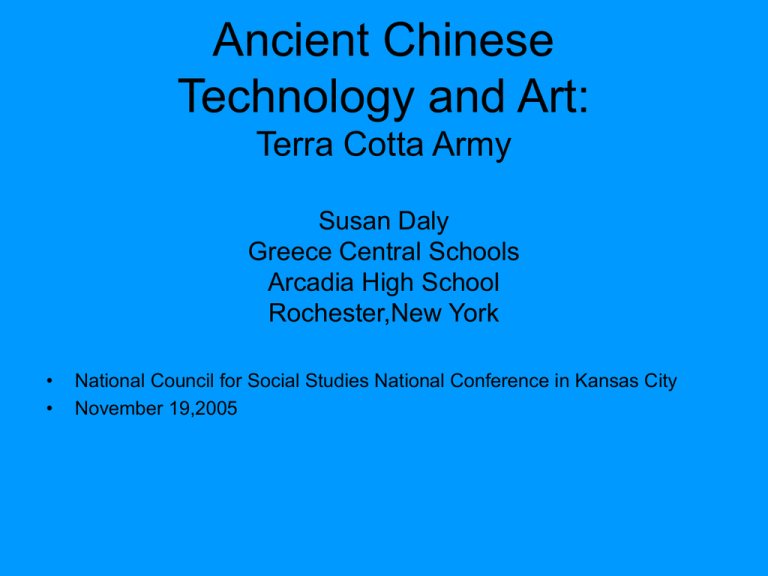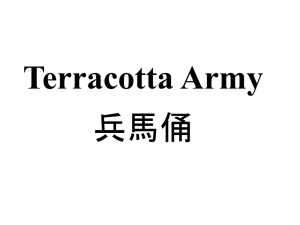The Terra Cotta Army of Emperor Shihuangdi
advertisement

Ancient Chinese Technology and Art: Terra Cotta Army Susan Daly Greece Central Schools Arcadia High School Rochester,New York • • National Council for Social Studies National Conference in Kansas City November 19,2005 My opportunity to travel and study in China, came about through the NCTA’s program of seminars for teachers. In 2002, I took a seminar in Rochester, through the Five Colleges Center for East Asian Studies at Smith College and then applied for and was then selected for the July, 2004 study tour of China. This opportunity allowed me to experience China for three weeks with 23 other teachers. Our study tour took us across China to 9 cities and countless historical places. Because China is such a huge country, in 3 weeks , we only scratched the surface by seeing many of the most famous places. We stayed on the campus of Beijing University where we had several lectures by professors. At the High School level,this presentation is intended for AP World history Global History ,including inclusive classes. It could also apply to some Middle school content areas. The Terra Cotta Army of Emperor Qin Shi-Huangdi Founder of the Qin dynasty 221-206 BCE. X’ian, China Most of my students know about 2 things from China. The Great Wall and the Terra Cotta Army. They are fascinated by both because of the scale of each. X’ian , where the army is located , means western capital. It was the starting point for the Silk Roads. Pit Number One In 1974, several farmers digging a well found the Terra Cotta Army in their field. They called in local authorities to examine the pieces they had uncovered. As they dug into this field , the archaeologists uncovered the army.They found 3 pits , each with different soldiers in them. This is the well which 3 farmers were digging when they found the army in 1974 The farmers who found the site in 1974, were paid about $500 for their land by the government. Today ,they work signing autographs for tourists who visit it and are paid a salary by the Chinese government. There are 3 large pits at this site. Pit 1 covers an area of 16,000 square meters . It is covered in a huge dome. Pit 2 covers an area of 7,100 square meters and includes bronze chariots. Pit 3 covers an area of 4,282 square meters and is the least excavated. Horses in Pit 2 Ramps to get the soldiers in. A group of ceremonial guards How long would it have taken to create over 7,000 separate soldiers out of clay ? What fuel would have been needed to fire these clay figures to make them into terra cotta ? Pit # 1 contains over 6,ooo soldiers Putting the army back together The army being reassembled Tera cotta is a hard semifired waterproof ceramic clay. When the warriors were first found, they were brightly painted. Since that time, the paint has been slowly disappearing. Archaeologists do not understand exactly what is causing the damage. The bundles are missing pieces When archaeologists work at putting the soldiers back together, they find potential pieces and create a bundle of them for each one. Then the workers searches for the location of a specific piece. If they find ONE PIECE in a day, they are very happy. Putting this gigantic puzzle back together will be the life’s work of many archaeologists. Individual Faces Every soldier has a unique face so the potters making them were probably modeling each one after a specific person. What can we learn 2200 years later about China at this time from these figures? An enlisted man An offficer and his horse Clothing and hairstyles show us the class differences which existed in this army. An officer has a topknot An archer without his bow Seeing the army Moustaches • Archaeologists have found 24 different types of moustaches on the soldiers faces. They show the range of social classes which the army came from. Individual differences could indicate social status or simply personal preference. Another view Archaeologists believe that each figure would have been fired at approximately 100 C in a kiln for a week. The figures were broken when wooden roof beams collapsed on top of them after a fire in antiquity. Officers in the front in battle formation This is how the army was found. It had been broken into many small pieces. Another view Cavalry troops Hairstyles show these were regular army Armies under repair Since few weapons of any kind were found with the soldiers, it is probable that they were stolen in the past so they could be used. A Ming era tomb on top of warriors Headless soldiers Pit Number Three The canvas covered areas are protecting soldiers from whatever environmental damage is degrading their paint. Continuing work here A cavalry officer with his horse A huge army being reassembled. The Terra Cotta Army was created in the neighboring mountains. Chinese archaeologists have found the kilns used to bake the statues. For the army, individual soldiers can be used to identify the area they came from through clothing design. What does this army tell us about how much political and military control the emperor had in his kingdom ? Bronze Chariot with umbrella Since bronze was expensive, the horses and chariot are smaller than life size. This chariot was recently shown in the movie “ Hero” . It brought the main character to a visit with Qin Shi Huangdi. Horses Bridle Silver and gold bridle In 1987, the Terra Cotta Army was placed on the list of World Heritage Sites by UNESCO. The site has been visited by approximately 40 million people in 20 years. It welcomes 1,500,000 visitors a year. Terra Cotta Army • 1. What is terra cotta ? • 2. How much clay would be needed to create an army of 7,000 soldiers? • 3. How would these life size soldiers have been fired ? • 4. What would have been the environmental damage done from supplying this much fuel ? 5. How would these figures be moved from the kilns in the mountains to the tomb site? 6. What happened to the final workers once all of the army was in place? 7. Baked clay fires at temperatures ranging from 500 C to 1150 C. How would this many kilns have impacted the local climate ? Chinese archaeologists know the location of Shi Huangdi’s tomb. They are waiting to open it, in hopes that future technology will allow more information to be discovered once it is opened.It also is supposed to have MANY unpleasant surprises inside.





